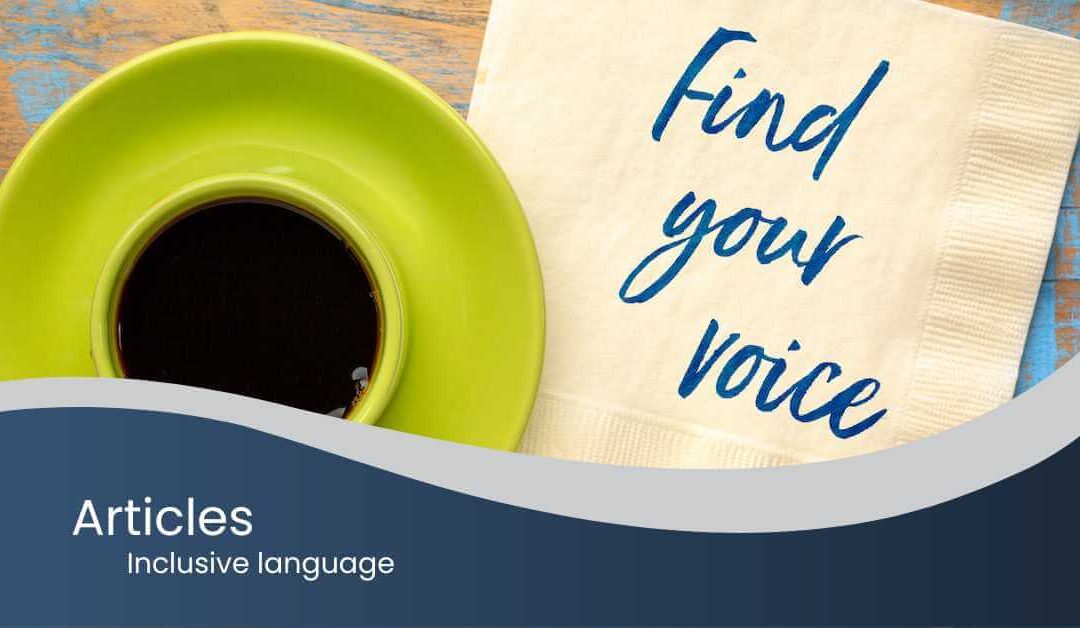Promoting access and inclusion through your brand’s personality
Actions don’t always speak louder than words. When it comes to your brand voice, what you say and how you say it reveals a lot about your organisation’s beliefs and values. Tone of voice guidelines are the ticket to clarity and consistency for your brand’s communication.
Developing your brand personality is also the perfect opportunity to set out your diversity, equity, and inclusion commitments. How will you talk to and about your diverse audiences? Which words and phrases are acceptable, and which are no-go zones? Embed these preferences in your tone of voice document. That way, everyone who creates content for you can accurately and consistently reflect who you are and how you want to show up for your communities.
What is tone of voice?
Is there a brand whose ads make you smile? Or an organisation whose social posts always leave you feeling a little smarter? These are often intentional personalities aligned with a brand’s purpose and values. The words they use in their communication are selected to convey a mood or feeling.
Brand style guides detail your visual identity through logo, brand colours, typography, and layout. Tone of voice guidelines set out what you say and how you say it. They articulate how you feel about what you do, and how you want others to feel when they interact with your organisation.
Also known as a brand voice, this document sets out your organisation’s preferred style of communication. It serves as a reference tool to ensure consistency across all your written and verbal content; from your website and social media posts, to your printed brochures, ads, and email footers. Even podcasts, videos and public events.
Knowing who you are clarifies your story
Self-knowledge leads to greater self-confidence. But does everyone communicating on behalf of your organisation share your depth of knowledge? Articulate who you are and what you stand for with a detailed tone of voice guide.
Creating brand voice guidelines means thinking about your purpose and values. It also means trying to see your organisation through the eyes of your audiences. What do they want from you, and how do you assure them you can deliver?
According to Start With Why author Simon Sinek, “People don’t buy what you do. They buy why you do it.”
Consumer insights reports back this up, showing people buy from organisations that reflect their own values. Features and price are important, but shared values will lift you above your competitors.
Your brand personality guide clarifies who you are, what you value, and why. It helps you reach people who share your ‘why’ and want to hear your messages.
How do you choose a personality?
Sometimes brand personalities emerge naturally. A hen’s party service might use cheeky and playful language. A business start-up keen to disrupt their sector might opt for a more edgy, controversial approach.
These days, communications tend to be more informal. But what does that mean for you? Is a splash of swears OK? Or do you prefer to come across as friendly but respectful?
If you’re not sure how to pinpoint your brand personality, seek inspiration. Look beyond your organisation. Even outside your sector. Think about businesses or individuals whose communication you admire. Look at their brochures, web sites, social posts, interviews, emails. What do you like or dislike? Knowing your values and how you want to sound is the starting point. Developing comprehensive brand voice guidelines sets out how you will achieve it.

What to include in tone of voice guidelines
The path to your unique brand persona kicks off with a detailed questionnaire. You could have one person complete it, or choose people from across your business for a range of perspectives.
A brainstorming session comes next. This draws out ideas, finds common ground, and sets a clear direction.
Your tone of voice copywriter will gather all this information and combine it with customer and industry research. They will then draft an initial brand voice guide for your review. Depending on the size and complexity of your organisation, the guide may include:
- A checklist of words to use and words to avoid
- Your unique service proposition, or USP
- Your brand positioning, vision, and principles
- Target audience profiles
- Key messages
- Style and grammar conventions
- Content samples to serve as a guide
What is an inclusive tone of voice?
The language you use reflects your beliefs and values. Are you committed to diversity, equity, and inclusion? Make it clear through your communications. This sends a message to your key audiences about the type of organisation you are.
Offensive or culturally insensitive words risk turning people away. Don’t let improper language undermine the important work you do.
Inclusive language shows respect to the diverse communities that make up our society. It assures people they will feel welcome when they use your service, or come onboard as a volunteer or employee. It gives potential donors confidence that you are an organisation with shared values.
It also shows leadership if others in your sector persist in using outdated language.
You don’t need to be militant about language choices. Always respect how individuals choose to describe themselves. But it helps to have guidelines to direct the communication your organisation puts out. Tone of voice guidelines are the ideal place to set out the way you want to say things.
What does inclusive language mean?
At its core, inclusive language is about respect. It’s about selecting words and expressions that avoid excluding individuals or groups of people. It lets the world know you do not discriminate on the basis of age, gender, sexuality, race, religion, culture or disability. That you aim to avoid stereotypes and biases.
Inclusive language is an expression of welcome. It is a signal of safety, letting all people know they will be listened to and valued.
Pay attention to your community’s preferences. Be an ally through your words and actions. This is one way to we can all help build a fairer and kinder world.
Add an inclusive language statement
Not everyone will agree with your language choices, and that’s OK. It is impossible to keep everyone happy. Remember that you have done the research, listened to your audiences, and made conscious choices.
Why not put this into an inclusive language statement to display on your website? An inclusive language statement outlines your language choices, the reasons behind them, and why they are important to your communities. Consider including an abbreviated version or link to the statement at the end of blogs or social posts.
Listen to your community, and review your language choices. Give people an opportunity to get in touch and make their feelings known. It can be a useful way to collect feedback to inform future language choices.
Language is always changing. The important thing is to stay connected to your audiences and listen to their preferences. If those preferences change over time, it’s OK to change too. It means you are listening and learning.

Speak your values
With audiences putting their money where their values are, there is a growing expectation for organisations to wear their hearts on their sleeves. Are you comfortable taking a stand on social issues? Your brand voice guide can make your position clear for anyone assigned to create your content.
First Nations
How do you acknowledge First Nations peoples in your organisation? Your tone of voice guidelines can set out respectful language, and boundaries around when to join the conversation.
Will you participate in discussions around the Indigenous Voice to Parliament referendum, NAIDOC Week, and Reconciliation Week? How will you approach the 26 January public holiday?
If you have a Reconciliation Action Plan how does that affect your communications?
How will you word your Acknowledgment of Country, and where will you use it?
First Nations names for places and geographic features are becoming more common. Will you put the European name first and Indigenous name in brackets, or the other way around?
Include your choices in your tone of voice style guide so there is never any confusion about what to say and when.
Disability
There’s lots of discussion around the language of disability. If your communication centres on an individual, it is best to ask their language preference. But it also helps to have clear guidelines for your general communications.
In Australia, the disability community opts for a person-first approach. This means talking about a person with disability, rather than a disabled person.
When it comes to neurodivergences, such as ADHD and autism, the preference is for identity first. That means saying autistic person, rather than person with autism.
If possible, check in with your audiences. Be consistent and consider including the reasons for your choices in an inclusive language statement.
Gender and sexuality
No one should have to declare their gender. But the opportunity to include gender pronouns on social profiles, email signatures, and name badges can help build inclusion. For LGTBQIA+ individuals, these pronouns are a signal of safety and welcome.
In your communication, simple guidelines will make your content more inclusive and welcoming. Aim for gender neutral terms when describing relationships, such as partner rather than husband or wife. Don’t assume a person’s gender based on appearance or role.
Individuals might have differing views. If you are writing about someone who prefers a different term, respect their choice.
Deciding when to weigh in on social issues
With new awareness and observance events seeming to pop up every week, it can be tricky to know when to weigh in.
Keep it relevant by bringing it back to your values and your audiences. Your tone of voice document can include a checklist to help decide which issues are most important to participate in. This can also direct your choices for when to share posts from other social media accounts.
Don’t forget to make your communications accessible
As well as the words you choose, the way you present them also reflects how welcoming and inclusive you are to your audiences.
At least one in six Australians identify as having disability. If they can’t access your content, you are not being inclusive. From your web pages to your PDFs, making your content as accessible as possible is central to your tone of voice guidelines. It sets the expectation for everyone creating content for your organisation. You could even include an accessible content checklist.
Digital accessibility is an ongoing commitment. Let your audiences know what you are doing to improve content accessibility, and give them an opportunity to offer feedback. An accessibility statement is a helpful way to achieve this.
How to use your tone of voice guidelines
When your brand persona is ready, share it with your team. Make the full document available, but also circulate a cheat sheet for quick reference.
Ensure new team members know of the document, as well as any consultants and external content creators.
It helps to maintain a live version of the guide to add language changes and update your sample content. This live version could be managed by your marketing or communications team.
Your tone of voice guide is a living document. Personalities develop, language evolves. Be prepared for the document to grow and change, circulating updates to your team as required.
A clear tone of voice benefits every brand
No matter the size of your organisation, tone of voice guidelines can help. Scale them up or down according to your specific needs. Once complete, this document will provide valuable clarity and consistency for your communications.
It reduces uncertainty and confusion, giving anyone who needs to create content for your organisation a clear roadmap for expressing who you are, what you stand for, and how you can serve your audience’s needs.
Get reliable communication support for


